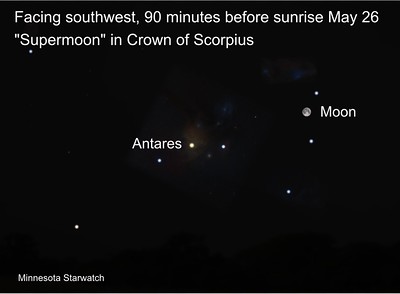Northern Sky: May 8-21
“Northern Sky” - Deane Morrison
May 8 – 21, 2021
As the winter constellations head into the sunset, Mars struggles to avoid the same fate.
May Day finds the red planet on course to glide between the bright stars Procyon, in Canis Minor, to the east and Capella, in Auriga, the charioteer, to the west. At the end of the month, Mars will be close to Pollux, the brighter Gemini twin. All the while, the planet is steadily dimming and, despite its relatively fast orbital motion eastward, sinking toward its inevitable exit from the evening sky this summer.
In the southeast to south, Spica, Virgo’s only bright star, is outshone by brilliant Arcturus, high above it in Bootes, the herdsman. To Spica’s lower right is a misshapen rectangle of stars marking Corvus, the crow.
To the north, the Big Dipper—part of Ursa Major, the great bear—begins the month upside down, “spilling its water” on Polaris (the North Star) and Ursa Minor, the little bear. To identify Polaris, follow the “pointer stars” at the end of the Big Dipper’s bowl. Bracketing Polaris are two brilliant stars: Capella, in the northwest, and comparably bright Vega, in Lyra, the lyre, in the northeast. During the course of a night, or from night to night, this arrangement changes as the sky rotates counterclockwise around Polaris.
In the predawn sky, look for Jupiter and dimmer Saturn low in the southeast. Thanks to the resurgent sun, we have to get out earlier each morning to see them against a dark sky.
The night of the 25th-26th, May’s full “supermoon” will be large and luminous as it slips through the Crown of Scorpius, a line of three stars near Antares, the scorpion’s red heart. The moon undergoes a total lunar eclipse on the morning of the 26th, but sets before the moment of perfect fullness and also before the eclipse reaches totality.
This will be the year’s closest full moon. It reaches perigee, the moon’s closest approach to Earth in a lunar cycle, only about nine and a half hours before reaching fullness. It edges out the runner-up, April’s supermoon, by a razor-thin margin. According to NASA, May’s full moon will be closer than April’s “by about 98 miles, or about 0.04 percent of the distance from the Earth to the Moon at perigee.”
Tweet




